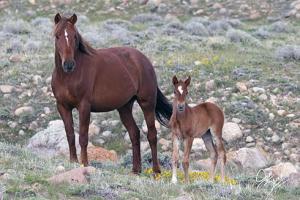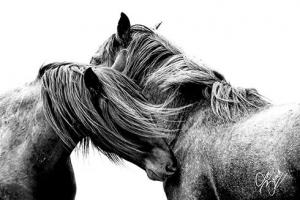The Preventable Travesty Of North Lander And Reasonable Request To Cancel Roundup
Jim Brown, renowned wildlife photographer, has lived in the region his entire life. He studies, photographs and defends the horses and their right to continue living undisturbed on the land where they do no damage and have thrived for millennia. Brown has never witnessed horses from these 4 distinct areas intermingling and has stated that the terrain and distances are not conducive to horses transferring between HMAs.
The National Academy of Sciences (NAS) recommendation for herd size to maintain genetic diversity is 245 horses. With the intermingling idea unproven this places each of the 4 NLC HMAs in danger. Each herd should be considered separately and the pitfalls of not meeting these herd numbers must be identified. Excessive inbreeding (mating of close relatives) can cause the downfall of viability in a herd and eventually lead to extinction.
The low Appropriate Management Levels designated by the BLM will take each of the 4 herds far below safe numbers for herd health and genetic viability as prescribed by the NAS.
Wyoming experienced the worst winter (2022-2023) in 50 years. Though payouts were made to ranchers for livestock losses the BLM is accounting for no winter kill in the horse herds.
Brown has witnessed winter kill horse carcasses in all 4 HMAs totaling a loss of over 180, although he admits, “the numbers may be 10 times what I saw because many of the areas are so remote that I could not access them.”
The BLM range condition reports and commitment to maintaining biodiversity are refuted by Erik Molvar, Executive Director of Western Watershed Project, “Public lands designated for wild horses are often grazed by domestic livestock. However, BLM typically does NOT consider the ecological impacts of domestic cattle and sheep. Wild horses are labeled ‘overpopulated’ when the livestock are exerting far greater pressure on the vegetation. Agencies prioritize reductions in wild horse populations, they seldom alter the number of cattle and sheep authorized to lease the same lands for grazing.”
Sandy Sharkey, wildlife photographer and global wild horse adventure guide said,”I traveled over 1400 miles to experience wild horses of Wyoming's North Lander complex. They are the wildest of the wild; federally protected with the right to a life of freedom on public lands. Driving from dawn to dusk through NLC, capturing images of wild horses proved difficult. The vast areas of the wild horses' rightful land were dotted with thousands of privately owned cattle. Wild horses on North Lander's public lands symbolize freedom. Privately owned cattle on NLC’s public lands symbolize greed. The BLM's summer removal of 2700+ wild horses should concern every American citizen. This is your land, and these are your wild horses.”
The BLM often claims that horses must be removed to prevent starving. Photographic evidence from Brown’s frequent visits to the herds show horses that are fit and healthy.
Brown reports pregnant mares and young foals (baby horses) currently with the herds and is concerned for the safety of both. Being chased by low-flying helicopters over miles of rough terrain during the hottest part of the year puts very young and older horses in greater danger and pregnant mares have been known to prematurely abort foals in these circumstances.
Advocates for Wild Equines Lobbying Coalition core team member, Brenna Wright commented,” When motorized vehicle use was approved for capture in 1976 (after the 1971 Act originally banned it) an annual hearing was added as a requirement to address serious concerns that reinstating motorized vehicle use in any way for the capture of wild horses and burros would be inhumane. (Federal Land Management and Policy Act, FLPMA). When the provision of law was codified, the regulation stated that hearings would occur annually in the area where the use of motorized vehicles would be employed in capture.” Wright added, “The law is pretty clear… BLM is required to hold an annual hearing in the area where such use would occur. A hearing has NOT been scheduled in this area.”
The National Environment Policy Act requires a period of public comment after they have presented an Environment Impact Study (EIS). Following the public comments adjustments are to be made to the EIS. BLM employee, Clay Stott, when questioned about all of the phone calls and e-mails that came in reported to Brown that, “those opinions do not matter to us.”
In the wild foals are generally weaned at 8 to 9 months although Brown has noted, “Most young wild ones will stay with the family band until the spring of their third year. The bond between mares and offspring is strong. When the BLM roundup takes place weaning time is when they say and foals can be separated from their dams very early.”
With such obvious indications of both financial and policy malfeasance, we ask that the roundup be cancelled until a full investigation by an impartial agency is completed and publicly reported.
Barbara C Moore
Equine Collaborative International, Inc
+1 716-912-2100
411eci@gmail.com





